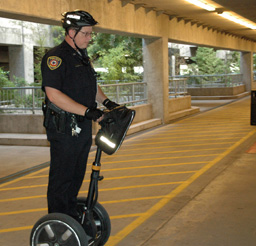By Shelly Williams/managing editor

Students may scoff at the image of cops on motorized scooters like Paul Blart: Mall Cop, but the truth is TCC’s police department has gained some advantages as officers patrol the campuses in this modern fashion.
About four years ago, former Chancellor Leonardo de la Garza saw the idea for the Segway, a self-balancing, two-wheeled patrol vehicle for the TCC police department, at an airport and decided TCC should have them, said South Cpl. Greg Bowen, who is over the bicycle and Segway patrol department.
A request for them was made by de la Garza soon after, and now each campus has at least one, including the new Trinity River Campus.
“Most of them are down at TRC because they’re more convenient at TRC than the other campuses,” Bowen said. “It’s just basically used to patrol around the buildings, sometimes inside the buildings. Mostly enclosed areas, like TRC, is really good for it.”
He said the Segways help place the officers and students almost on a level scale, making the police more approachable and easier to talk to, instead of students becoming intimidated by larger patrol vehicles.
“It does encourage the students to talk with us,” TR patrol officer William Cook said. “And that’s kind of what we want. We want to be able to interact with the students. It’s a great conversation starter.”
Bowen, who trains officers to use the Segways, said that the contraption is easy for someone to operate. Training takes about an hour. Officers practice stepping on and off the Segway and moving the Segway in different directions. They watch a training video as well. All officers must be certified to use the machine.
“We have had an injury, but that’s just the nature of it,” he said. “As far as funny stories, there aren’t any really, though we have had one person run off into the bushes. But that’s just a part of it, though. He will never do that again.
“I like it, but I’m kind of closer to the bike because it’s more physical, and I feel like I have more control over the bike. But those that don’t want to ride a bike have this option.”
Bowen said officers don’t have to worry about balancing the Segway, but that stepping onto the machine is like stepping onto a boat while it’s on water. Officers just have to get their sea legs, he said.
“I was a little nervous at first because it was an unusual looking device, but I found it to be easy to ride,” Cook said. “I think the Segways are great.”
Bowen said, overall, officers have a black-and-white perspective of the machine — they either like it or they don’t.
“If it’s something they’re interested in, they’ll say it’s really neat. It’s fun to ride,” he said. “And then there are other officers who say, ‘I’m not getting on that thing.’”
